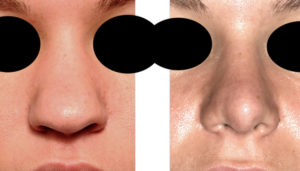
Cutting the nasal bones, known as nasal osteotomies, is what gives one bruising under the eyes after surgery. While not all nasal bone cuts result in significant ‘raccoon eyes’, most such rhinoplasty manuevers will. The nasal bones are cut with the objective of either narrowing one’s wide upper nose or to close what is known as an ‘open roof’ which develops after taking down a large hump on the nose. This allows the nasal bones, or sidewalls of the upper nose, to fall inward. This movement not only narrows the bony width of the nose but also allows it to assume a more triangular shape (if you were looking at it in cross-section) so that the bridge of the nose is not flat. Even if one’s nasal bones may not look too wide before surgery, they may be come so when other parts of the nose are changed, particularly the tip of the nose.
The wearing of a nasal splint after rhinoplasty helps keep the nasal bones in their new position as they get ‘sticky’ during the first week after surgery. After one week, there is no longer any need to hold the nasal bones in place as there is little risk of them ‘falling back out’.
In some cases, a broad upper nose may not be helped by cutting and narrowing the nasal bones. This is particularly true in the broad but flat upper nose which usually has almost a saddle appearance. The solution here is to build-up this portion of the nose, which will give the visual appearance of being narrower as it height increases.
Dr. Barry Eppley
Indianapolis, Indiana


